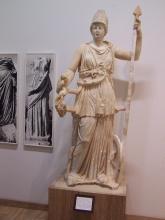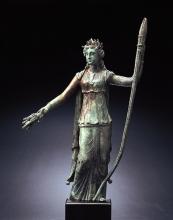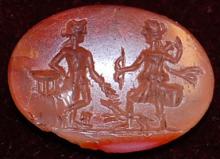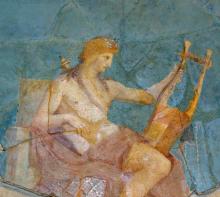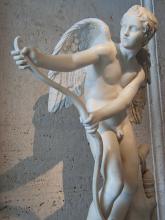Arma gravī numerō violentaque bella parābam
ēdere, māteriā conveniente modīs.
pār erat īnferior versus; rīsisse Cupīdō
dīcitur atque ūnum surripuisse pedem.
“quis tibi, saeve puer, dedit hoc in carmina iūris?5
Pīeridum vātēs, nōn tua, turba sumus.
quid, sī praeripiat flāvae Venus arma Minervae,
ventilet accēnsās flāva Minerva facēs?
quis probet in silvīs Cererem rēgnāre iugōsīs,
lēge pharētrātae virginis arva colī?10
crīnibus īnsignem quis acūtā cuspide Phoebum
īnstruat, Āoniam Marte movente lyram?
sunt tibi magna, puer, nimiumque potentia rēgna:
cūr opus adfectās ambitiōse novum?
an, quod ubīque, tuum est? tua sunt Helicōnia tempē?15
vix etiam Phoebō iam lyra tūta sua est?
cum bene surrēxit versū nova pāgina prīmō,
attenuat nervōs proximus ille meōs.
nec mihi māteria est numerīs leviōribus apta,
aut puer aut longās cōmpta puella comās.”20
questus eram, pharetrā cum prōtinus ille solūtā
lēgit in exitium spīcula facta meum
lūnāvitque genū sinuōsum fortiter arcum
“quod”que “canās, vātēs, accipe” dīxit “opus.”
mē miserum! certās habuit puer ille sagittās:25
ūror, et in vacuō pectore rēgnat Amor.
sex mihi surgat opus numerīs, in quīnque resīdat;
ferrea cum vestrīs bella valēte modīs.
cingere lītoreā flāventia tempora myrtō,
Mūsa per undēnōs ēmodulanda pedēs.30
notes
1.1 Ovid Finds His Muse
The poem begins with a metrical and generic joke. The poet was preparing to write epic poetry: his first word is the same as the first word of the Aeneid, and he would have continued writing in dactylic hexameter, except that apparently Cupid “stole a foot.” [full essay]
1–2: Arma: a weighty and tradition-laden first word, coming after Vergil’s famous Arma virumque canō (Aeneid 1.1). gravī numerō: numerus here means "meter" (of verse). The meter in question was dactylic hexameter, which as the meter for Greek and Latin epic poetry was considered the most serious of the meters. ēdere > ēdō -ere -idī -itum, "to emit, bring forth, produce"; also "publish." Barsby observes that it is unlikely that Ovid was really planning to write an epic, even though he elsewhere talks about his subject, the battle of the gods and giants (Amores 2.1.11–16); his claim about epic owes more to the traditions of the recusatio poem, in which poets of "lighter" verses explain their reasons for avoiding epic. māteriā: scansion reveals that the final a is long, and that the word is therefore ablative; it frequently happens that scansion is essential to establishing the meaning of a line. modīs: modus can mean "rhythm" or "meter."
3–4: īnferior: here the "lower" verse; Ovid had been writing dactylic hexameters, so that his second line was equal (metrically) to his first. dīcitur: "is said" + infin. rīsisse. ūnum ... pedem: pes here means "foot" in its metrical sense; in elegiac verse the second line of each couplet is a dactylic pentameter: it is similar to the dactylic hexameter of epic poetry, but shorter by a foot.
5–6: in carmina: "over songs"; for in + the accusative with words expressing power or control, see OLD 11b. iūris: partitive genitive, with hoc (AG §346.4). Pīeridum ... sumus: the emphasis here is on Pīeridum and tua: "we poets are the Muses' entourage, not yours." Pīeridum > Pīeris -idos f. "daughter of Pierus," i.e. a Muse. vātēs > vātēs -is, m. "a prophet"; "a poet" (here plural). A vātēs was a more formal and religious kind of poet than a mere poēta.
7–8: quid: interrogative; understand dīcās or something similar; quid thus provides the apodosis of the condition introduced by sī praeripiat. flāvae: Minerva (Athena) was proud of her golden hair; she had turned Medusa's hair into snakes for boasting about hers. arma: Minerva/Athena was often depicted wearing breastplate and helmet and carrying a spear. ventilet: a second protasis, connected to praeripiat by an adversative asyndeton (i.e. the absence of a connecting word), indicating high excitement and/or a strong contrast. facēs > fax, facis, f. "torch"; a symbol of Venus. A fine Minerva from the theater at Leptis Magna, now in the Jamahiriya Museum in Tripoli, Libya, shows the goddess with her traditional offensive and defensive arma: spear, helmet, shield, and the goat-skin aegis that served as her distinctive breast-plate.
9–10: probet: potential subjunctive (AG §447.3). Cererem > Cerēs, -eris, f. Ceres, the goddess of grain and agriculture in general. lēge > lex, lēgis, f. "law," but here perhaps "jurisdiction"; notice that (as in line 8) the clause is in asyndeton, to express excitement. pharētrātae: the reference is to Diana (Artemis), the goddess of the hunt. colī > colō colere coluī cultum, "to cultivate, till, farm." A Roman bronze Statuette of Ceres from the Miho Museum, Kyoto, Japan (1st c. AD), shows the typical depiction of Ceres in Roman statuary and coins: standing, with ears of wheat in her right hand, extended as if offering them; in her left hand is a lighted torch (sometimes a sceptre). An intaglio made of chalcedony from the British Museum shows Diana with her trademark short tunic (to allow for easy movement while hunting), holding a bow in her right hand, and with her left hand removing an arrow from her quiver (pharetra).
11–12: crīnibus: ablative of respect, with insignem; Apollo was famous for his flowing locks. acūtā: "sharp" in two senses; Apollo is often said to sing acūtā vōce, but the adjective is transferred to Mars’ spear. īnstruat: potential subjunctive, (AG §447.3). Āoniam > Āonius -a -um "of Aonia, Boeotian"; Aonia was a region of Boeotia, in which was situated Mt. Helicon [Google Earth Map], home of the Muses. movente: another double meaning, since moveō is used for the wielding of weapons and for the playing of musical instruments. A gold coin of Augustus, struck in 15 BC, right at the time the three-book edition of the Amores was published, shows the head of Augustus on the obverse, with the legend "Augustus, son of the deified (Caesar)." On the reverse is Apollo with long hair, carrying a lyre or cithara, a plectrum in his right hand. Apollo was a god highly favored by and closely associated with the princeps. A fragment of a wall painting from the Palatine Hill in Rome, found in the rubble of what is believed to be Augustus' residence, shows Apollo as he is often represented: long, elaborately done hair (crinibus insignem) and holding a cithara.
13–14: ambitiōse: another example of the necessity for scansion; the e is short, not long, so ambitiōse is vocative, not an adverb.
15–16: an: a particle introducing a direct question, usually indicating some surprise or indignation (AG §335b). quod ubīque, tuum est?: i.e., id, quod ubīque est, tuum est? "Do you own everything everywhere?" Heliconius, -a, -um: "of Helicon" (see note on Aoniam above). tempē is an indeclinable neuter pl.; originally a proper name, for the Vale of Tempe in Thessaly, but used for any pleasant valley. sua refers to Phoebus, even though the subject of the sentence is lyra; suus -a -um can be used to place emphasis on the fact that a thing belongs to one person rather than another (AG §301c).
17–18: surrēxit > surgō -ere surrēxī surrēctum, "to arise"; used also of the beginning or expansion of literary works. We would expect the present tense of the indicative in a temporal cum clause, but the perfect emphasizes that the action is a completed one, in contrast to that described in the main clause (AG §473a). Translate: "each time a new page has been started nicely with a first verse" (i.e. the first line of an elegiac couplet). proximus ille: refers either to the inferior versus of line 3, or less probably to Cupid.
19–20: numerīs: as in line 1, numerus means "meter." aut ... aut: = nec ... nec, because the nec on line 19 has made the whole sentence a negative one. puer ... puella: Ovid can assume that the elegiac meter and love poetry go together, thanks to his predecessors Catullus, Gallus, Propertius, and Tibullus. Of these, Catullus and Tibullus (as well as Horace, though not in elegiac couplets) wrote poems to both male and female lovers. longās ... comās: the so-called Greek accusative (also called accusative of part affected, accusative of specification, and accusative of respect), (AG §397b).
21–22: ille: referring back to Cupid. solūtā > solvō solvere soluī solūtum, "open up"; Cupid’s quiver had a top on it. in exitium: in + acc. can express purpose.
23–24: genū: ablative of means (AG §409). Cupid used his knee to help with bending the bow: when stringing a composite bow you push the bow away from you with your knee (or thigh) to break the initial stiffness. (I am grateful to a former student, David Stiffler, for his advice on composite bows.) sinuōsum: Cupid’s bow (a composite bow) looks wavy rather than crescent-shaped when unstrung. quod ... canās: relative clause of purpose (AG §531.2). The line is written with intentional staccato to reflect Cupid's abrupt and violent response. Several Roman copies exist of a lost 4th century BC Greek statue by Lysippos of Cupid stringing his bow. The best is probably the second century AD version in Capitoline Museum, Rome, and it shows clearly the use of the knee to curve the sinuous compound bow.
25–26: mē miserum: accusative of exclamation (AG §397d). in vacuō pectore: the author’s heart had been empty, up to this point. Amor = Cupīdō.
27–28: mihi: dative of advantage (AG §376). surgat ... resīdat: hortatory subjunctives (AG §439). sex ... numerīs, in quīnque: the reference, as in lines 1-3, is to the elegiac couplet, consisting of a line of dactylic hexameter followed by a line of dactylic pentameter. ferrea ... bella: vocative. modīs: as in line 2 modus means "meter."
29–30: cingere > cingō cingere cīnxī cīnctum "to encircle, to wreathe"; second person singular passive imperative. lītoreā > lītoreus -a -um "of the seashore." Notice the scansion, which reveals that lītoreā modifies myrtō (on which see below). tempora > tempus -oris, n. "the temple" (of the head), "forehead." Greek accusative/accusative of specification, as above in line 20 (AG §397b). myrtō: the myrtle was sacred to Venus, who was born out of sea foam (hence lītorea). The names of trees in Latin are regularly second declension, but feminine (AG §32). per: for per + accusative to indicate instrument see OLD 15. undēnōs: an elegiac couplet has eleven feet in all, whereas two lines of hexameters would have twelve. ēmodulanda: the word is used only here in Classical Latin. Greek myrtle (myrtus communis) from the Berkeley Botanical Garden.
vocabulary
1
violentus -a -um: violent, savage
versus -ūs m.: line of writing, line of verse
Cupīdō -inis m.: Cupid
surripiō -ripere -ripuī -reptum: take away secretly, steal
Pīeris -idos f.: daughter of Pierus, i.e. a Muse [image]6
praeripiō -īre -iī -itum: snatch, carry off
flāvus -a -um: golden; fair-haired, blonde
Venus -eris f.: Venus
Minerva -ae f.: Minerva
ventilō -āre: wave, fan; brandish
accendō -cendere -cendī -cēnsum: kindle, set afire
Cerēs -eris f.: Ceres [image]
rēgnō -āre: be king, rule
iugōsus -a -um: hilly, mountainous
pharetrātus -a -um: wearing a quiver [image]10
crīnis -is m.: lock of hair; (pl. or collective sg.) hair
insignis -e: distinguished, remarkable, notable
acūtus -a -um: sharp, piercing
cuspis -idis f.: sharp point, tip (esp. of a spear)
Phoebus -ī m: Phoebus
instruō -struere -strūxi -strūctum: equip, furnish; prepare, provide
Āonius -a -um: of Aonia, Boeotian [map]
Mars Martis m.: the Roman god of war
lyra -ae f.: lyre [image]
adfecto -āre: strive after, grasp at
ambitiōsus -a -um: ambitious, eager
ubīque: anywere, everywhere
Helicōnius, -a, -um: of Helicon [image] [map]
tempē: (indecl. noun, n. pl.) the Vale of Tempe in Thessaly; any pleasant valley [map]15
pāgina -ae f.: page
attenuō -āre: make thin; weaken
nervus -ī m.: muscle, tendon; cord, string
cōmō cōmere cōmpsī cōmptum: make beautiful, adorn; dress, arrange, comb20
pharetra -ae f.: quiver
exitium -ī n.: destruction, death
spīculum -ī n.: sharp point, sting, arrow
lūnō -āre: make crescent-shaped, bend back
genū -ūs n.: knee
sinuōsus -a -um: full of windings; sinuous
arcus arcūs m.: bow; arch, arc
sagitta -ae f.: arrow
25
ūrō ūrere ussī ustum: burn
sex: six
quīnque: five
resīdō -sīdere -sēdī: sit down, sink down, shrink
ferreus -a -um: made of iron; hard-hearted, cruel
lītoreus -a -um: of the seashore
flāvens -ntis: golden, yellow
tempus -oris n.: the side of the forehead, temple
myrtus -ī m./f.: myrtle [image]
Musa -ae f.: a Muse [image]30
ūndēni -ae -a: eleven each, eleven at a time
ēmodulor -ārī: measure out; put into meter

